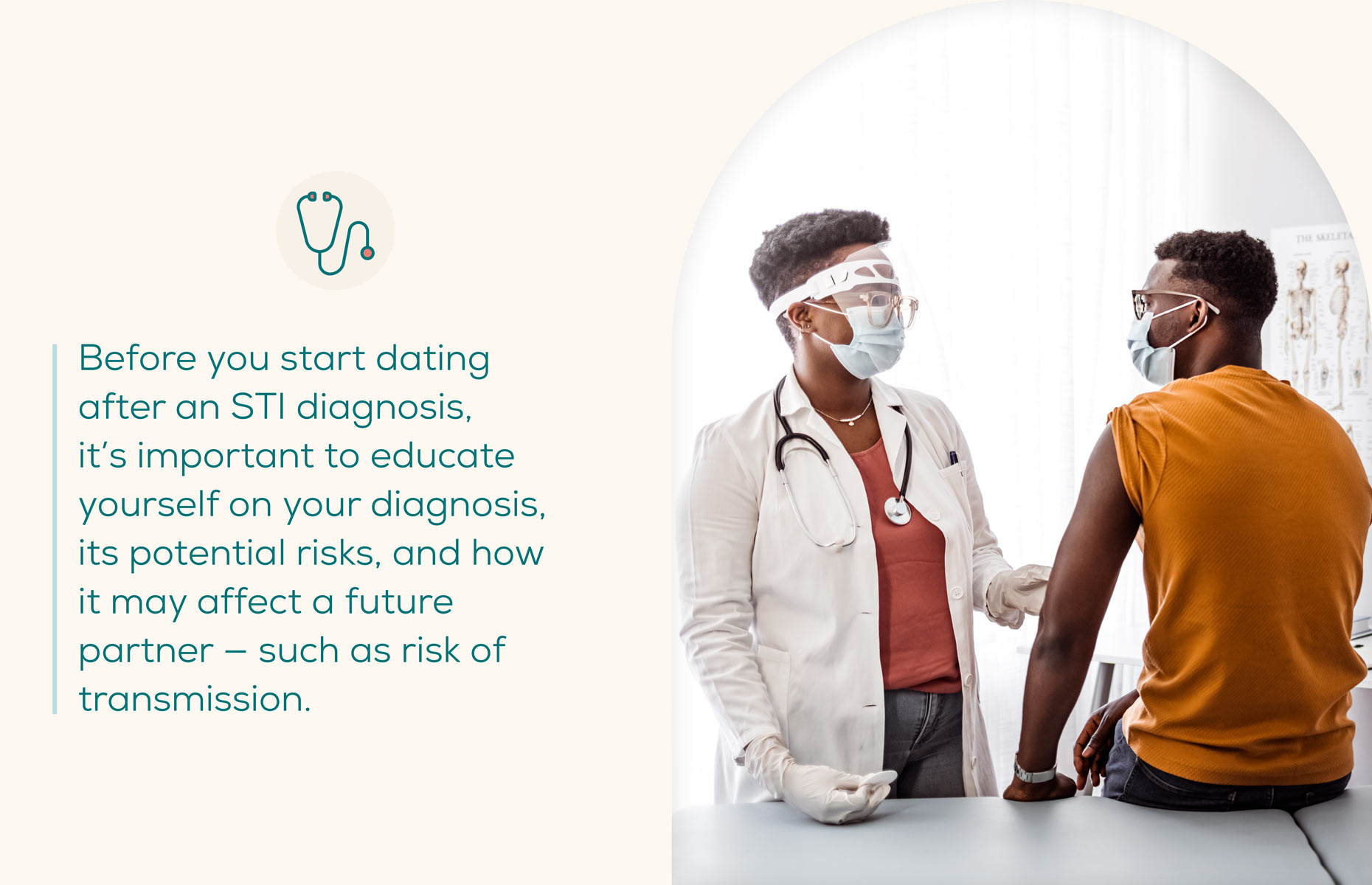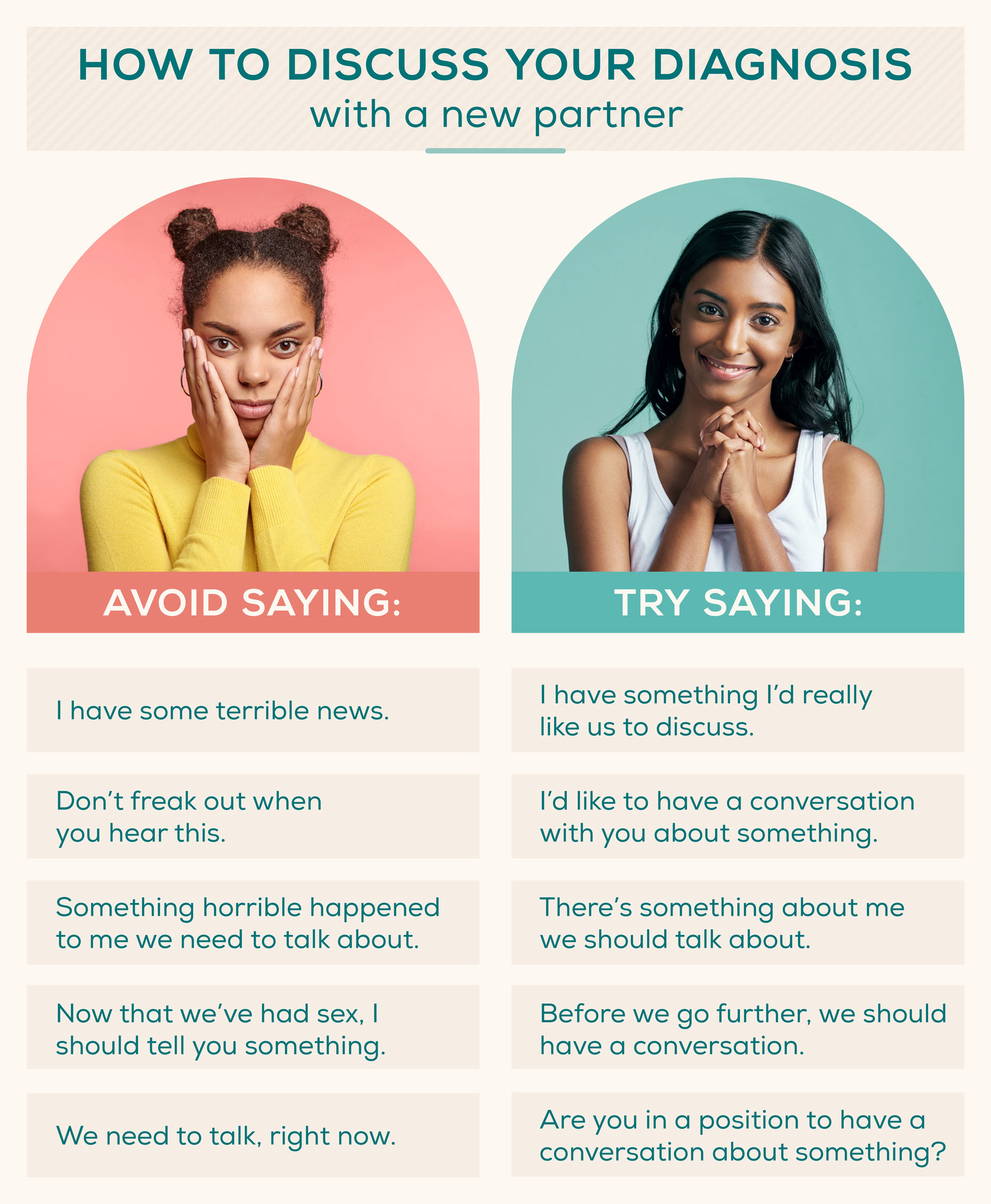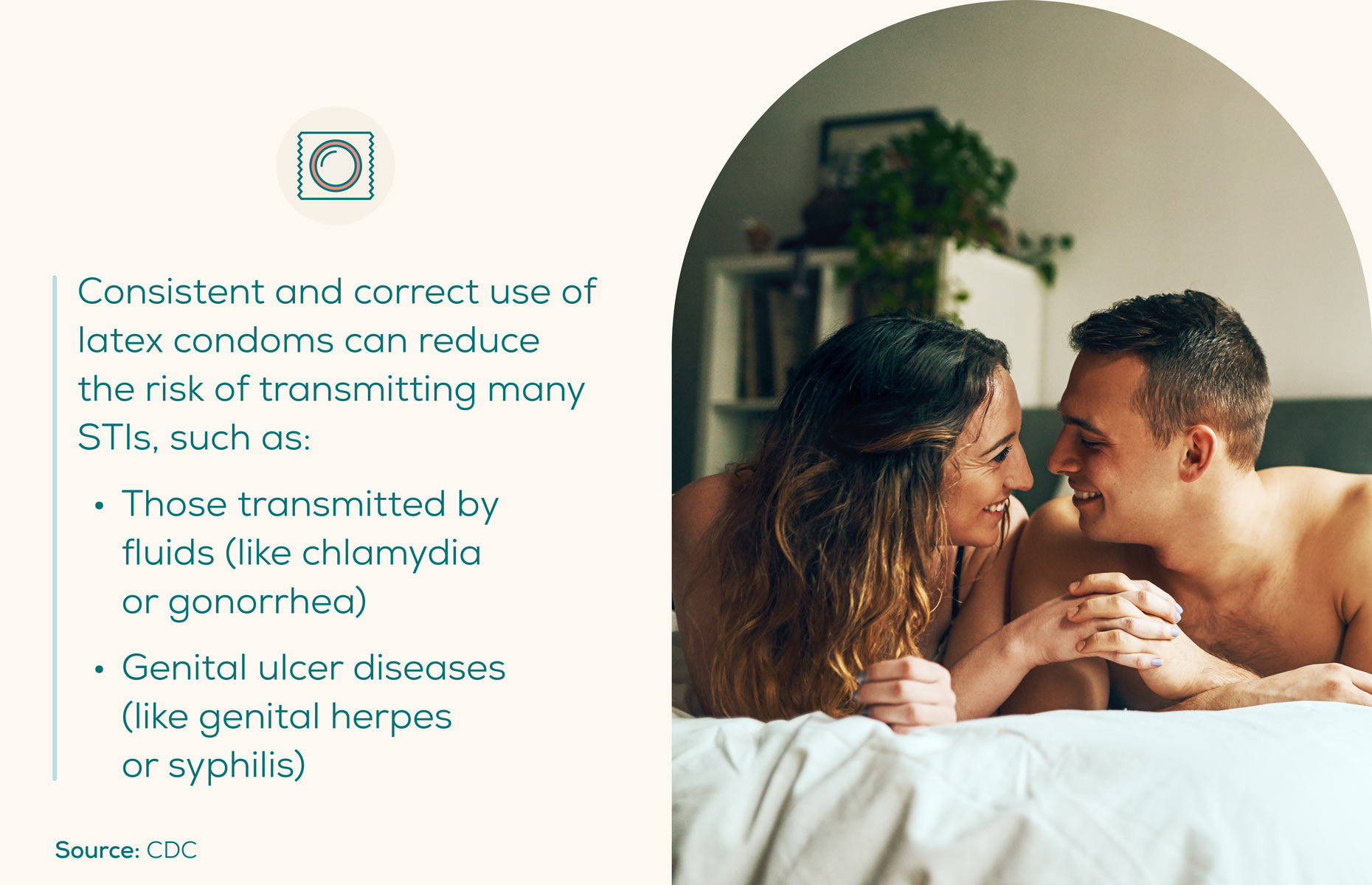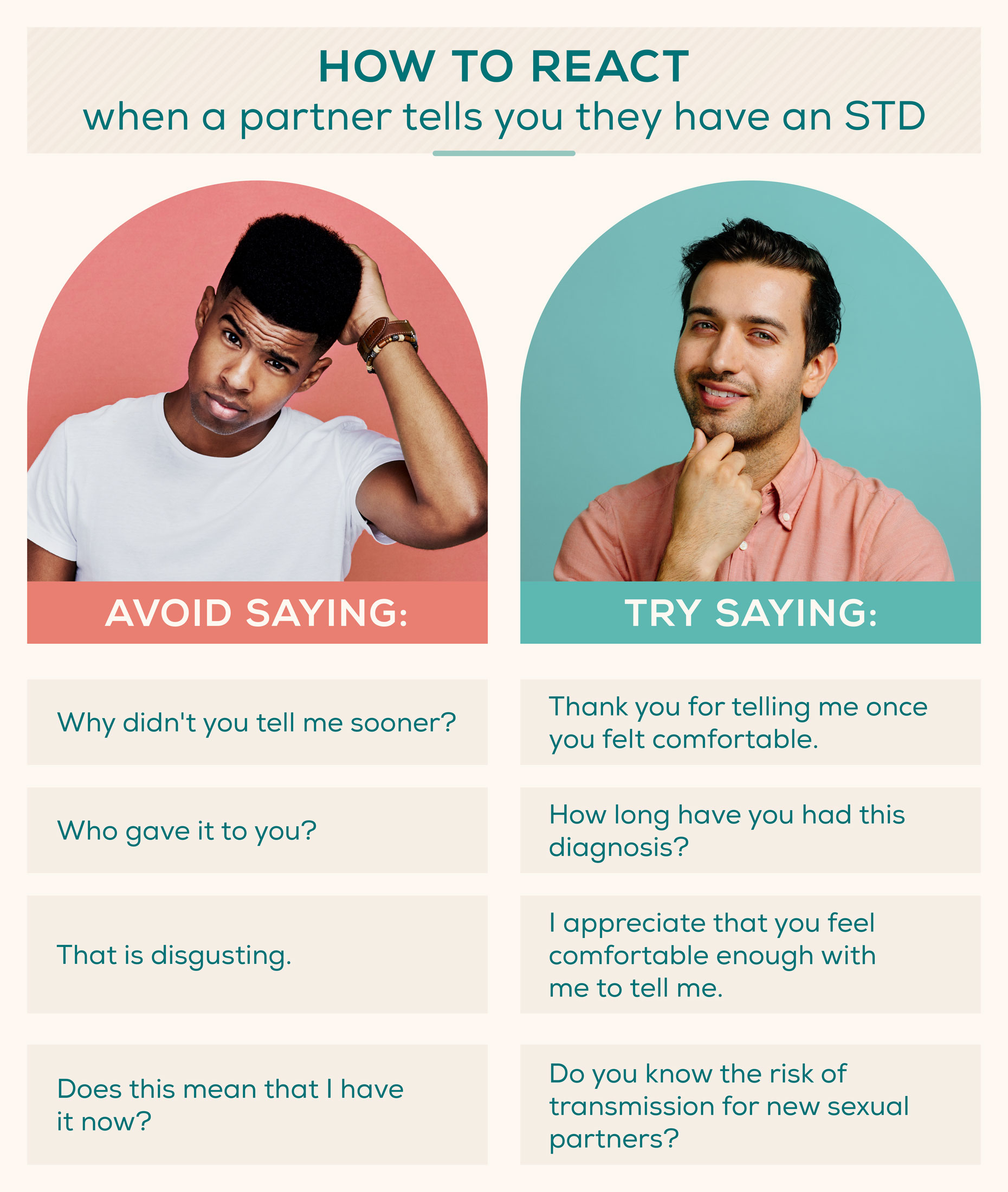
Guide to dating with an STD: how to communicate openly and stay safe
Published January 4, 2022.
For the sixth year in a row, sexually transmitted disease (STD) and infection (STI) diagnoses recently reached an all-time high, particularly among young adults ages 18–24. Most people diagnosed with these conditions are able to be treated or have their condition managed with medication or regular testing, and can live normal lives.
Entering the dating pool with an STI can feel stressful and overwhelming, but it doesn’t have to be if you’re armed with the proper knowledge to take the plunge.
Table of Contents
- How to Talk About STIs on a Date
- When to Discuss Your Diagnosis
- How to Prevent the Spread with Safer Sex
- What to Do if Your Partner Has an STI
- Ways to Feel Confident After a Diagnosis
- Additional Resources
- Related content
How to Talk About STIs on a Date
STIs generally fall into two categories: curable and chronic. Certain STIs, such as chlamydia, gonorrhea, and syphilis, can be treated with medication and eventually cured. If you’ve been diagnosed with a curable STI, it’s generally recommended to not have sex until your diagnosis is cleared up.
Other STIs are considered chronic illnesses — such as herpes, HIV, and some types of hepatitis. Since these STIs stay with you as you age, it’s important to learn how to safely date while living with one.

With a New Partner
Before having sex with someone for the first time, it’s not uncommon (and actually recommended) to discuss your STI status together. This helps you both ensure you’re on the same page about your health and wellness, and provides an easy segue to discuss your diagnosis. Some people may have preconceived notions about STIs and believe myths about them, so having an open and honest conversation is key.
When discussing STDs with a new partner, it’s important to think about how you want them to take the news. You likely don’t want them to view your diagnosis as the most awful news they have ever heard, so be careful not to present it that way.
Be direct, unemotional, and prepared to answer their questions.”The disclosure should happen early enough to prevent the possibility of infecting the other, but not so early where you are sharing your status while shaking their hand,” said David Khalili, LMFT, a San Francisco-based sex and relationship therapist.
With an Existing Partner
When discussing an STI diagnosis with an existing partner, try to handle the conversation with the same care and directness that you would if you were sharing the news with a new partner.
If you’ve been together for a while, this news may come as a surprise to your partner. If needed, suggest getting tested and speaking with your doctor together about treatment options going forward.
Michael Mahgerefteh, MD, an integrative psychiatrist specializing in STIs, notes, “Once a connection is formed, both you and your partner will understand and appreciate these STDs for what they are — an incredibly common and easily manageable nuisance that may actually become a vehicle for exhibiting vulnerability with a partner, which may help form an even deeper bond.”

When (and How) to Discuss Your Diagnosis
One of the biggest sources of anxiety you may feel when dating with an STI is when and how to have “the talk” about your diagnosis. While it all comes down to personal choice and when you feel most comfortable discussing some serious medical news, it’s generally recommended to tell your partner before your first sexual encounter together.
Withholding this information until after sexual intercourse could not only damage your relationship, but could be dangerous for their health and wellness.
How to Prevent the Spread with Safer Sex
Once you have discussed your status with your partner, you both may feel ready to introduce sex into your relationship. Having an STI does add another reason to use protection, but this should not preclude you from having safe, enjoyable sex with your partner.
While there’s no method of protection that’s 100% safe and prevents your partner from testing positive, there are some methods you can use to keep one another as safe as you can.
- Wear protection. Consistent and correct use of both female (or internal) condoms and latex condoms reduces the risk for many STIs that are transmitted by genital fluids (such as trichomoniasis, chlamydia, and gonorrhea), and genital ulcer diseases (such as genital herpes or syphilis). This also may reduce the risk of spreading human papillomavirus (HPV) and therefore developing HPV-related diseases (such as genital warts or cervical cancer) in the future.
- Get tested. Even if you aren’t actively experiencing symptoms, it’s still possible to pass a disease to someone else. Your partner should discuss when and how often they should be tested with their healthcare provider, as well as monitor any symptoms that may present.
- Keep each other informed. Having an open and honest line of communication with your partner can lead to a new level of intimacy within your relationship. Let each other know when you are or aren’t in the mood, are experiencing symptoms, or think you should get tested to keep communication open in your relationship, especially as you explore a sexual relationship together.

What to Do if Your Partner Has an STI
Dating means meeting many different people, and with the uptick in STI diagnoses, it’s likely you may date at least one person who has been diagnosed with an STI. If you don’t have one, but someone you’re seeing tells you that they do, it’s important to know how to respond.
Be sure you’re really listening as they explain their diagnosis, and ask any questions that you may have regarding their STI.
Keep in mind that this is a highly vulnerable time for your partner, so how you respond is very important. Put yourself in their shoes — how would you want your partner to respond to this news? Let them know you respect and appreciate them for letting you know, and discuss whether or not you feel comfortable continuing your relationship or exploring a sexual relationship.

3 Tips to Boost Confidence After a Diagnosis
A new STI diagnosis has the potential to affect many parts of your life, from your confidence to how ready you feel to date — but it doesn’t have to. Dr. Mahgerefteh recommends that before you begin dating after a diagnosis, you must first accept and feel comfortable in your own skin (particularly with a lifelong one, like herpes).
According to Dr. Mahgerefteh, this means educating yourself about the disease, its risks, and how it may impact any future partner, including risk of transmission. Once you’ve accepted your new diagnosis, then you can feel confident in yourself to begin dating again. Learn more about ways to feel confident entering (or re-entering) the dating pool, with only a few first date jitters.
1. Download Dating Apps for Other Positive People
One of the biggest stressors for those who begin dating after an STI diagnosis is how and when to reveal their status to their date. Many worry that this conversation could lead to rejection, a breakup, or furthering the stigma that having an STI is something to be ashamed about.
Luckily, there are a number of dating apps and websites that are specifically designed to connect people with lifelong STIs, such as herpes, or HIV/AIDS. This can help ease any awkwardness around ”the talk” of revealing your diagnosis, and can help ensure that both parties are on the same page about their status prior to engaging in any sexual activity.
Some of these apps and websites include:
- Meet Positives: For STI-positive people to avoid “the talk” and feel normalcy entering into a new relationship
- OkCupid: Has a special section on the site for dating with STIs so positive people can meet others in a similar situation
- Positive Singles: A safe dating space for people with STIs to meet and date without worry of rejection or discrimination
Herpes:
- H-Date (for both herpes and HPV)
- Herpes People Meet
- HSV Singles
- HWerks
- MPWH
HIV/AIDS:

2. Care for Your Mental Health
Dating is hard for everyone, STI diagnoses aside. Consistently being vulnerable and upfront about your status can be mentally taxing, so it’s vital to care for your mental health and practice self-care as you navigate dating with an STI.
Below are a few ways you can prioritize yourself during your dating journey:
-
Remember that you are worthy. Dating can be hard for everyone, especially if you're facing rejection, being “ghosted,” or a string of bad dates. It’s important to remind yourself that you are worthy of love and are complete without a significant other, even in the midst of discouraging dates.
Khalili suggests, “If you do feel shame and guilt about your STD, remember that you are far more than this infection. Just because you have an STD does not mean you are bad, wrong, or unclean.”
-
Explore mental health resources. It may be triggering to date and explain your status to strangers, which can take a toll on your mental health. If they are available to you, try seeking out mental health resources (such as talk therapy) to help you while you explore dating with an STD. There are numerous resources you can utilize while you navigate life with an STI, including:
- CDC-INFO (formerly known as the CDC National STD Hotline): 1-800-CDC-INFO (1-800-232-4636); available Monday–Friday, 8 a.m. to 5 p.m. (Eastern time) in both English and Spanish. Counselors available to answer questions about HIV and other STIs and direct you to testing locations.
- Planned Parenthood U.S. National Sexual Health Hotline: 1-800-230-PLAN (1-800-230-7526); available Monday–Friday or as local call hours permit. Call to be directed to a Planned Parenthood near you for counseling for STIs, pregnancy, or other sexual health questions.
- The Trevor Lifeline: 1-866-4-U-TREVOR (1-866-488-7386); available 24 hours a day. Online chat or talk via phone with someone who listens, understands, and won’t judge your feelings or any suicidal thoughts.
-
Repeat positive mantras before dates. Not every date is going to lead you to your soulmate, but that doesn’t mean you shouldn’t go in with an open mind. Try repeating positive mantras to yourself ahead of dates so you going into each date with a confident mindset, such as:
- I am desirable and worthy of love.
- The right person will make me feel like I’m enough as I am.
- I do not fear rejection, because that brings me one step closer to success.
- I am open to love, no matter how it presents itself.
- I am in charge of my own romantic journey and destination.
3. Continue to Keep an Open Dialogue with Your Partner
Even after having “the talk” with someone you’re seeing, you should still have a regular open line of communication with them regarding your status. Get tested and keep them informed of any flare-ups or new symptoms, especially after being sexually active together, to stay in the know and in control of your health.
Additional Resources
To keep yourself and any future partners safe and informed, try utilizing these resources on STI testing and information.
STI At-Home Testing Resources:
- Chlamydia & Gonorrhea Test
- Hepatitis C Test
- HIV Test
- STD Test – Female
- STD Test – Male
- Syphilis Test
- Trichomoniasis Test
Additional STI Resources:
- American Sexually Transmitted Diseases Association
- CDC: Effective Interventions
- CDC: STD Treatment and Screening
- CDC: The Facts About STDs
Living with a lifelong STI can make dating seem even harder and more stressful than it is ordinarily, but it doesn’t have to feel that way. Through transparent communication and regular testing, you can have a normal dating experience that fulfills both your emotional and sexual needs.